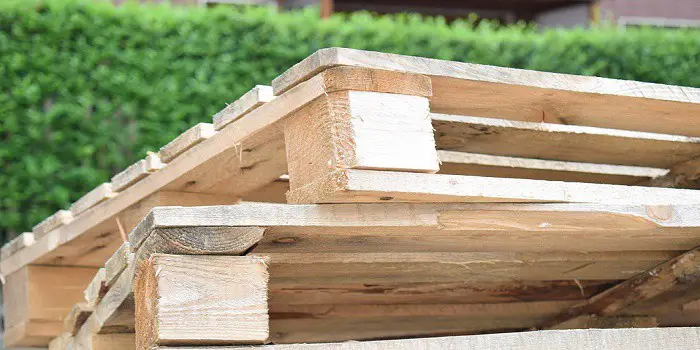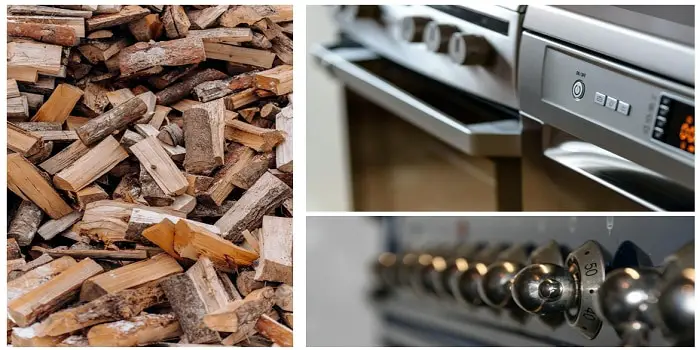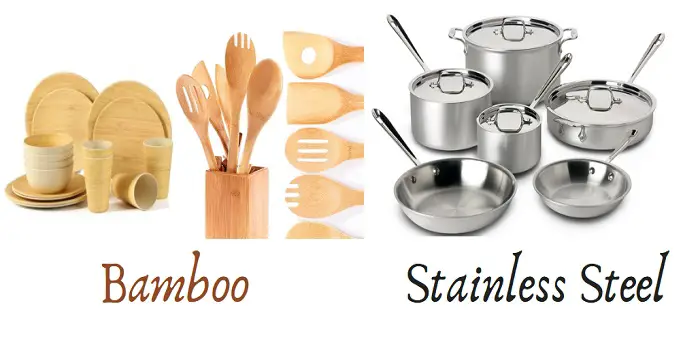
Only recently have bamboo utensils become well-known around the world.
While many people use stainless steel utensils, the advantages of bamboo have made them a popular consideration for many households.
This is because they offer some advantages that wood or stainless-steel utensils simply do not offer.
But is bamboo really better than stainless steel?
It pays to know both materials before making your decision as to which is best for your home.
Bamboo Utensils – Pros & Cons
As with any material, there are positives and negatives to using bamboo utensils in your home.
Let’s start with the advantages…
The Good Part
1- Beautiful Design:
The most noticeable advantage of bamboo utensils is their inherent beauty.
They simply look great whether you are using them for dinner or displaying them on a rack.
You’ll be proud to show off your bamboo utensils in the kitchen.
You can even order a custom design if you desire when choosing a company that does that type of work.
2- No Scratches:
If bamboo has one solid attribute above stainless steel, it’s the resistance to scratching.
Stainless steel is relatively easy to scratch, while bamboo rarely does because of its softer nature.
This means when applied to metal surfaces, bamboo utensils tend to stay intact.
3- Environmentally Friendly:
Bamboo, much like wood, is a natural resource that is biodegradable.
This means that it will not pollute soil, above-ground, or underground water sources when disposed of.
Plus, bamboo grows much faster compared to trees, which means that you can help save the forest when choosing bamboo.
Also, they react well to heat, unlike plastic utensils which may leak out toxins.
4- Resistant to Odors & Stains:
One perceived drawback that is a myth about bamboo utensils is that they stain easily and carry odors collected from food.
However, that is not true, as bamboo has a tough surface that does not allow stains to stick or odors to collect.
5- Non-Conductive Material:
Bamboo is far more resistant to conducting compared to stainless steel.
This means that if you leave a bamboo utensil behind in a heated pot, it will still be cool enough to the touch.
They are perfect for soups and risotto that require considerable stirring to get right as your hand stays cool.
6- Better for Non-Stick Surfaces:
The problem with using metal utensils on non-stick surfaces is that they tend to create scratches.
Bamboo is soft enough not to scratch such surfaces, so it can remain intact and functional for much longer.
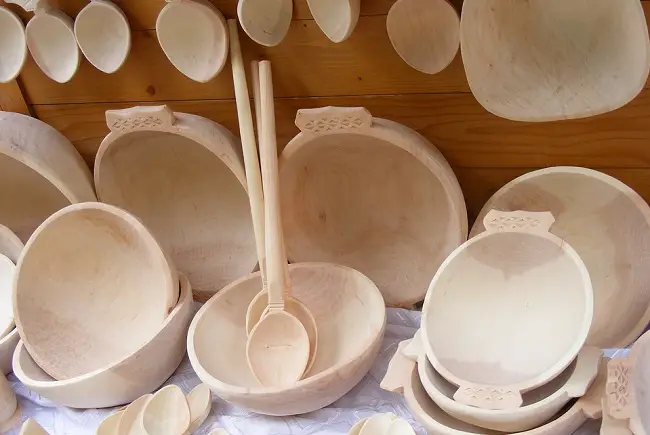
The Bad Part
Despite the many advantages of bamboo, there are some issues that you will need to know about.
These may not be deal-breakers, but they should be considered before you make a purchase.
1- Breakable:
The biggest downside is that bamboo is breakable.
Unlike stainless steel, which is virtually not breakable under most circumstances, it is possible to break bamboo under certain conditions.
2- Hand Washing:
Bamboo utensils are not dishwasher safe unless noted specifically with the brand that you purchase.
This means that you will need to wash them by hand.
3- Availability:
While bamboo utensils are becoming quite popular, they are not available everywhere.
So, if you order them, they may take longer to arrive, assuming they are not in stock.
Plus, they are not as available in local retail stores compared to stainless steel.
Stainless Steel Utensils – Pros & Cons
Stainless steel utensils are by far the most popular material used for utensils, and for many good reasons.
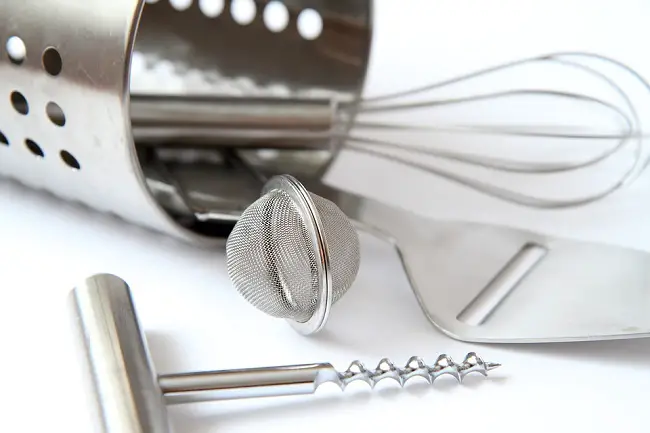
The Good Part
1- Durable:
It would take quite the impact to break or even bend a stainless steel utensil.
This means that they will last a very long time, often a lifetime and longer, with minimal maintenance.
That’s why they make a great investment because such utensils can be passed down from generation to generation.
2- Recyclable Material:
Consider that more than half of the stainless steel utensils being used right now are made from materials that have been recycled.
This means that no new digging took place to mine the materials; it was created from metal scraps that already existed.
Plus, the metal can be recycled again and again, so they are never disposed of in the ground.
3- Resists Corrosion:
While iron-based products such as steel will rust easily, stainless steel has a coating that will keep them from rusting.
This means that even when stored in a moist, humid, and hot environment, they will continue to resist corrosion and rust.
Plus, the surface will also resist stains, dents, and dings.
4- Cleaning:
Because of its tough surface, stainless steel is easy to wipe and clean.
You can stick them in your dishwasher or wash them by hand, your choice.
They require little in the way of maintenance, but you can occasionally use a stainless steel cleaner to make them look new again if you desire.
5- Heat Transfer:
This is more for cookware than utensils, but stainless steel is an excellent material because it transfers heat so well.
This is why you find cookware made from this product in kitchens around the world.
6- Available:
Unlike bamboo, which can be difficult to find in some locations, stainless steel utensils are virtually everywhere in terms of retail stores that sell utensils.
No special orders or long waits are needed because of the availability of stainless steel utensils.
The Bad Part
Despite the considerable advantages, there are a few issues with stainless steel that you will need to consider.
1- Scratches:
Arguably the biggest downside to stainless steel utensils is their vulnerability to scratches.
They will most often scratch when stored together and handled, so you may want to mix in utensils made from bamboo to limit the scratching potential.
2- Heavy Metals:
While the steel itself is food-safe, some manufacturers will use metals such as nickel or chromium to coat the surface.
These metals can, over time, leach into the food you eat, creating conditions ripe for metal poisoning.
However, they do not apply to all stainless steel utensils.
3- Pricey:
While low-quality stainless steel utensils are quite affordable, the higher-quality versions can be quite expensive compared to bamboo.
If you are looking for elegant, beautiful stainless steel utensils, you can expect to pay more for them.
Bamboo or Stainless-Steel Utensils: Verdict
Overall, the bamboo utensil has the edge over the stainless-steel versions.
This means that if you want utensils that look great, are strong and durable, and will not transfer heat like stainless steel, then bamboo is the answer.
However, you should consider having some stainless-steel utensils as well.
They can be used in situations where bamboo utensils are not well-suited.
Knowing how you prepare and serve meals, combining bamboo and stainless steel may work quite well for your kitchen.
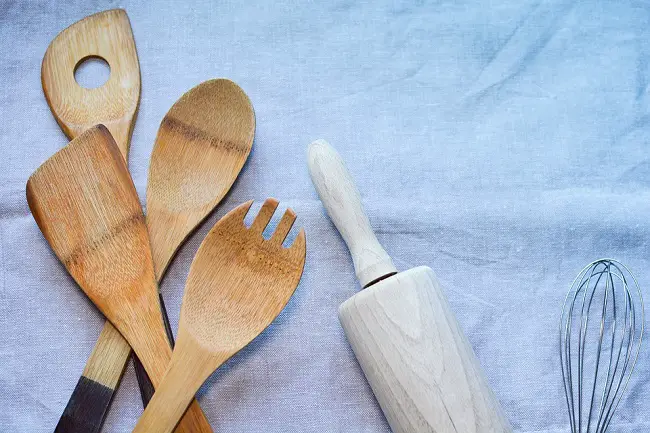
How to Care for Your Bamboo Kitchen Tools & Utensils?
It is true that bamboo utensils, despite their many advantages, will need a little extra care and maintenance compared to stainless steel versions.
But with that care, your bamboo utensils will last for a long time.
a) Before Using
When you get your bamboo utensils, they will most likely be untreated.
If you rub food-grade mineral oil into the wood utensils and then let them dry for 24 hours, you can help keep them from splintering.
Plus, the bamboo utensils will have a smooth finish that will help them last for a long time.
So, before you use your bamboo utensils, give them a rub down with food-grade mineral oil and let them sit for 24 hours.
This will help increase their durability and longevity by avoiding most instances of splintering.
b) Hand Washing
Bamboo utensils do not do well in dishwashers because the intense heat (due to detergent and hot water) will remove their protective coating and cause them to warp.
Soaking bamboo utensils for a long time in the water will also cause them to warp and splinter.
This is why you should wash and rinse your bamboo utensils in the sink fast.
After each use, place the wooden spoons, plates, bowls, cutting board, muddlers, and other utensils under running water and scrape any food residue.
Then, dry them using a dish towel or set them out to dry, whichever you wish to do.
Just remember to minimize their exposure to water which will help keep them from warping.
c) Removing Stubborn Stains
Despite your diligence, there may be times when your bamboo utensils get stained to the point where they cannot be easily removed.
When this happens, avoid the temptation to use harsh chemicals, as that will only do more damage.
Instead, take the following steps…
1. Coarse Salt:
Rub the salt into the stain using a sponge.
Keep rubbing until the stain is removed, and then rinse.
2. Baking Soda:
Rub baking soda into the stain using a sponge.
Let the utensil sit for a few minutes to let the baking soda do its work, and then rinse. Repeat if necessary.
d) Removing Odors from Kitchen Tools
While bamboo utensils do not tend to hold odors from food, you can improve their scent by using a combination of salt and lemon juice.
Apply both to the utensils and let them sit for a few hours.
This will allow the combination to penetrate the surface and create a pleasing scent on the utensils.
Also, you can sprinkle baking soda on the utensils and let them sit for a while.
Baking soda eliminates any odor that might be emanating from surfaces.
e) Restoring the Finish of Bamboo Kitchen Tools
While bamboo is tough, the finish can wear away after years of use. You can, however, restore the finish in short order if you follow these steps.
1. Fine Sandpaper:
The easiest way is to use very fine sandpaper on the surface. This will remove imperfections and stains that cannot be removed.
2. Warm Water:
While it is never advisable to soak your bamboo utensils, the one exception is when they are flat such as cutting board.
Soak the bamboo cutting board in warm water for a few hours, place it on a flat surface, and place a flat object like a book on top.
This will restore the cutting board to its original shape.
FAQs
What are the best materials for cooking utensils?
Stainless steel is one of the best options for cooking utensils because it is durable and easy to clean.
The additional top layer of Chromium Oxide does not react with food, making these utensils corrosion-resistant.
Other good choices include cast iron, enameled cast iron, and ceramic cookware.
Glassware and wood are also popular materials for cooking utensils, but they require more care and maintenance than others. They can also be more expensive than quality stainless steel products.
When choosing the best material for your kitchen, choose materials that are durable and easy to clean.
What kind of wood is best to use for kitchen utensils?
Hardwoods (from deciduous trees) make the best and safest cooking utensils you can use in your kitchen. They are less porous, resistant to rot, and have a tighter grain than wood from softwood trees.
Generally, the lumber that comes from trees growing edible fruits is the safest and most non-toxic to be used for kitchen utensils.
In that regard, maple, cherry, olive, teak, oak, Sapele, and beech hardwood are all excellent options for making cooking utensils such as spoons, forks, cups, straws, chopsticks, etc.
Much like bamboo, these Non-Toxic woods are less likely to crack than utensils made from pine.
Are silicone cooking utensils better than wood or stainless steel?
Silicone cooking utensils are a newer option on the market, and they have some advantages over traditional materials.
They are non-stick, which means that they won’t scratch your cookware, and they are heat-resistant up to 450 degrees Fahrenheit.
However, some people believe that silicone leaches chemicals into food, so it is essential to do your research before purchasing any silicone kitchenware.
In general, silicone kitchen utensils are a good option for most delicate foods, like eggs, fish fillets, and pancakes.
For non-delicate foods like steaks, chops, and burgers, wooden cooking utensils can be better to choose from.
Final thoughts
Bamboo utensils are a great alternative to traditional stainless steel kitchen utensils. They are durable, eco-friendly, and affordable.
Bamboo utensils are also available in various shapes and sizes to meet your cooking needs. You can find them at most home improvement stores or online retailers.
On the other hand, stainless steel kitchen utensils can be expensive and difficult to clean. Some cheaper ones may also contain harmful chemicals that can leach into your food.
So, in the end, if you’re looking for an environmentally friendly, pure, affordable, and durable option for your kitchen utensils, bamboo is the way to go!
Share the post "Bamboo vs Stainless Steel Utensils: What’s Better for My Kitchen?"

Hi, I am Mark Garner a professional carpenter, woodworker, and DIY painter. I live in the small city of Peoria, Arizona as a semi-retired woodworker. I have started this blog with a simple motive to help you with my wood experience in this sector. If you like to know more about what I love doing and how it all got started, you can check more about me here.


